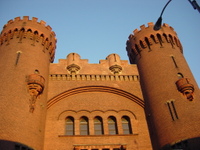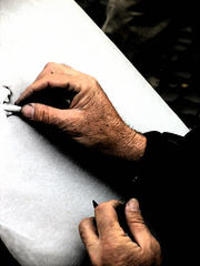When I got on at the Williamsburg Bridge Plaza bus station on Broadway, I asked the driver if anyone in their right mind actually takes this bus from here to Manhattan Avenue.
He smiled and said, “Yeah, you can get there much more directly if you just transfer for the B43, but some people do prefer the scenic route.”
“Okay,” I said. “I just didn’t want you to think I was crazy.”
I needn’t have worried, because that role was taken by one of the other passengers who got on at the first stop: a group of about fifteen middle-aged whites and Hispanics, with one young Hasidic man. We had barely gone up the few blocks of Rodney Street, along one side of the highway where Moses parted Williamsburg when a male voice shouted out: “FUCK DISNEY!”
After we turned on Metropolitan Avenue, the same voice shouted out: “FUCK THE DEMOCRATS!”
I couldn’t discern who it was and braced for the next shout, wondering who else would be singled out for opprobrium. But it never came. Whoever it was – and I thought the Hasidic man was staring at me as if he assumed I was the theme park-hating Republican – for the rest of the ride this person remained as quiet as a mouse (presumably not Mickey).
Metropolitan Avenue between the Brooklyn-Queens Expressway and Graham Avenue is my current stamping grounds, so I pretty much ignore the sights I see every day: my 24-hour laundromat, the Korean grocery where I shop when I’m too lazy to walk to the supermarket, the Brick Theater Company (I enjoyed some of the productions in its recent Pretentious Festival – no, that’s not a criticism, that was its name). We pass a car on whose back window is written with whatever that white stuff is: RIP GRANDMOM 1917-07/10/07. A lot of people get on and off by the Graham Avenue L station. Presumably some of them are transferring to the B43 bus for the shorter, non-scenic route to the hub of the Greenpoint shopping district. Of course there’s plenty of shopping right on Graham here, in the heart of gentrifying Italian Williamsburg. (On Sunday I kept walking back and forth between the hipster-filled concert at the McCarren Pool and the Giglio Festival closer to my house; the crowds at each event were quite different, but after awhile Jerry Vale and the Octopus Project began to sound rather alike to me.)
A few blocks east of Graham (also called Via Vespucci over here) on Metropolitan Avenue we make a slight turn onto a short stretch of Maspeth Avenue, for two blocks that probably win the prize in the highly competitive category of Brooklyn’s Ugliest Collection of New Luxury Condo Buildings. One of the monstrosities under construction appears to be complete but so structurally unsound that outside girders have recently been erected to hold the building together and keep it from falling down. I knew we couldn’t get that lucky anyway.
The Hasidic man, realizing we’re not going down Metropolitan Avenue to Jamaica, gets off at the next stop. The bus driver explains that at the bridge he should have gotten on the Q54 and tells him where to transfer. “Lots of people make that mistake,” the driver says.
We turn on Kingsland Avenue, alternatively named for a few blocks Grandparents Avenue. Huh? We pass the hulk of the long-abandoned Greenpoint Hospital and the Cooper Park Projects.
There’s a great documentary by Christine Noschese called Metropolitan Avenue originally shown two decades ago on PBS’s P.O.V. series that shows the decline of this part of
Williamsburg/Greenpoint – the Northside – as budget cuts and racial tensions exacerbated ongoing decay. It’s hard for newcomers to trendy “East Williamsburg” to imagine that this neighborhood appeared to be dying not all that long ago. Noschese’s film shows how the area’s working class women of different ethnic backgrounds – Italian, Polish, African Americans from the Cooper Park Projects and others – joined forces to lead the fight to save this community.
On the film you can briefly spot Agnes Grappone, who stands with her daughter and son-in-law Phil and Diana Mule when, in a roll call of neighborhood groups, they call out “Conselyea Street Block Association.” Agnes was the grandmother of my lifelong friend Nina Mule, and I am now living in what was Agnes’s house, in the apartment where I visited her in the 1970s.
Not that many years ago I was with Agnes at the Long Island nursing home as she lay dying a few months short of age 100. My dear landlady and friend, her daughter Diana or “Dee,” passed away rather suddenly at 84 last month, and we’re all still bereft. A beloved local elementary school teacher, Dee had over 350 mourners at her funeral at the church she attended all her life, and condolence cards are still coming in as I collect the mail every day. She was born in the house I now live in, and every time I open the front door I still expect to smell her delicious Italian cooking. An extraordinarily generous person, she will also be missed by the various charities and environmental, civil rights, civil liberties, feminist and liberal groups which still send her an average of two dozen letters a day.
Kingsland Avenue runs north to Greenpoint proper, but the B24 turns right at Meeker Avenue, the street running alongside the elevated Brooklyn-Queens Expressway, at this area’s only suburban-style fast-food joint, a freestanding McDonald’s with a parking lot.
And in a few blocks we enter onto the BQE, one of the few examples of a non-express city bus going on a highway, in this case officially I-278, but basically just the short hop over the Kosciuszko Bridge to Queens, with Newtown Creek below us.
But what a view of the Manhattan skyline. In the foreground Long Island City’s odd lone skyscraper, the 58-story Citi Tower looking directly across to its corporate sister on Lexington Avenue, the iconic Citi Center.
For me, this thrilling panoramic view of Oz-like Manhattan from south to north beats any other in the city. This is indeed the scenic route, about the only place you can have clear views of the Williamsburg, Queensborough and Triborough Bridges in one spot. On the south side of the expressway is a flatter but still interesting vista of extreme eastern Brooklyn and western Queens.
We get off the highway just over the bridge and go down 48th Street, filled with brick two-families. I always enjoy the signs at the corner of 48th Street and 48th Avenue, and then not long after, at the corner of 47th Street and 47th Avenue. This is Sunnyside. I usually get off, as most people do, just before we make the left turn onto Greenpoint Avenue, a block away from Queens Boulevard and the 7 train’s 47th Street/Bliss Street station.
Signs warn pedestrians trying to cross the Boulevard of Death to be careful or they’ll reach heavenly bliss before they make it to Flushing or Times Square. A secret: the B-24 to here and then two stops on the 7 train to Woodside can actually be the fastest way from Williamsburg to the Long Island Rail Road, swifter than a subway ride to Penn Station or Flatbush Avenue.
There’s a Starbucks here I sometimes dawdle at, as well as some cool South American and Central American restaurants and bakeries. Sunnyside is a terrific neighborhood worth exploring, although when I was younger I came here only for boxing matches at Sunnyside Gardens and a 1977 blind date with a guy I met through a personals ad in Aquarian Weekly. He was nice but, like another guy I’d dated a few years before, seemed offended that I was a teetotaler and made a futile attempt to “teach” me to drink. Both of these guys later turned out to be alcoholics although one became a Jesuit and the other a Franciscan.
Across Greenpoint Avenue we go, past many stores with Spanish signs. A Colombian diner offering a $5.95 midday buffet featuring sopa, carne, arroz, pasta ensalada y bebida seems to be doing a booming business.
The Greenpoint Avenue Bridge (everyone calls it that rather than the J.J. Byrne Memorial Bridge), built in 1987, is basically a low bascule containing a four-lane city street between Hunters Point and Greenpoint – yes, it’s Kingsland Avenue again, and then through the same Greenpoint north-south streets we saw the other way when we went east. To the right looms a zoom-in view of the Manhattan skyline we saw before: more intimate, but a little scarier somehow, like midtown is a monster that could crush us in this corner of little Brooklyn.
As we make our way to Manhattan Avenue, there are mammoth factories on either side of the street. I feel like I’m in Pittsburgh or Youngstown circa 1956 before the term “Rust Belt” was coined. I don’t think there’s any stretch of Brooklyn that feels so industrial.
And then we’re at the end, at Manhattan Avenue’s bustling strip of bargain stores, chains from Starbucks (the only one in the world with a marquee, it was the old Chopin movie theater) to Radio Shack, and endless Polish signs, products and people. I love this street. Last week I got 6 pair of socks here for $3.
The trip’s taken a little longer than half an hour. I make it back home, two stops on the G train, in about five minutes. Later in the day I walk from the Williamsburg Bridge Plaza, the start of the bus route, to its terminus near Manhattan and Greenpoint Avenues. I basically walk straight alongside the BQE and then up Manhattan Avenue and I’m there about ten minutes faster than I got there with the B24, but then again, it certainly isn’t the scenic route.



